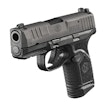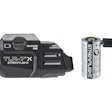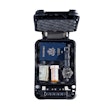When it comes to capturing, subduing, and arresting bad guys, law enforcement currently has four types of less-lethal and less-than-lethal tools: physical restraint such as handcuffs and Ripp Hobble restraints, chemical weapons such as oleoresin capsicum (OC) spray, electrical shock devices such as Tasers, and impact tools such as batons and Asps.
Ideally, we would like to have a less-lethal weapon whose impact is at once totally effective at extended range and totally safe. To date, no such less-lethal weapon exists. But could such a “phasers on stun” innovation be on the way? Maybe. Certainly Uncle Sam and numerous corporate entities are trying to develop the perfect less-lethal weapon.
Here’s a warts and all look at some of the wonder weapons that are in development or currently being tested by the military and select law enforcement agencies.
Super Glue
When you find yourself in a sticky situation, what better way to get out of it than with a sticky weapon? To this end, Sandia National Laboratories developed Sticky Foam.
The Albuquerque-based defense research lab’s chemical restraint system sounds like the ultimate police weapon. Sticky Foam solidifies upon contact with its target and, as the chemical hardens, the suspect is immobilized. It’s basically the equivalent of Spider-Man’s webs.
Fortunately for Spider-Man he lives in Marvel world and not ours, the one with the lawsuits and the liability. Back here in the real world, the use of Sticky Foam can lead to some unexpected and undesired consequences. You can actually kill people with the stuff.
Consequently, the protocol for using Sticky Foam dictates that the spray be deployed only from the waist down. Accidental facial contact through poor aim or the suspect’s own contamination, i.e. rubbing the stuff on his or her face, could cause suffocation. Emergency removal measures have been developed to neutralize the agent in the event of such exposure, but you can bet that lawyers are lined up waiting to sue law enforcement and the manufacturer for the survivors of the first Sticky Foam casualty.
Another problem with Sticky Foam is that it’s not easy to deliver the stuff on targets that happen to be outdoors. Wind conditions can diminish its stream, which means that the best application for Sticky Foam is to immobilize suspects indoors at a range of 50 feet or less.
Casting a Net
Another cool tool currently available in law enforcement’s arsenal is the WebShot. Available through ALS Technologies, this less-lethal system is exactly what it sounds like, a net that can be fired at the bad guys.
Capable of being launched via a standard weapon or recyclable launcher, WebShot envelops its target in a net that constricts both flight and fight movement. Once WebShot has done its job, the net can be removed via a two-person peel or simply cut off.
WebShot has some real pluses over some other immobilization weapons. It can be used outdoors and indoors and in a variety of weather conditions. This adaptability makes WebShot a candidate for not only capturing resistive suspects, but for neutralizing threatening animals, all the while minimizing potential injuries and collateral damage.
Gas Jet
Deploying chemical weapons in police or corrections applications has always involved two basic types of dispersal devices: short-range spray canisters and long-range launchers. There was no intermediate-range weapon for delivering OC. There is now.
Developed from a popular European self-defense weapon, Piexon’s Jet Protector JP-401 is a reloadable handheld OC weapon that can accurately launch 10 milliliters of the chemical irritant out to 21 feet. Each launcher holds four pyrotechnic cartridges of liquid OC.
The Swiss-made Jet Protector is now being evaluated for corrections applications by the Special Response Team of the Maricopa County (Ariz.) Sheriff’s Department. SRT Capt. Edward Cesolini says the gun-metal gray, four-barreled weapon has intimidated some inmates in the county’s tent corrections camps. “We pull it out, and they get that look on their faces like they’re not sure what to make of it.”
Cesolini was intrigued by one inmate’s reaction and, after the incident, he asked the man why he backed down when the deputies drew the Jet Protector. The subdued inmate responded, “I don’t know what that thing can do, but I know that I don’t want any part of it.”
The inmate made a good choice, Cesolini says. Deputies who have been shot with the Jet Protector in training have felt the effects for hours. “They’d much rather take another ride on a Taser than be hit with this again,” he explains.
Which is why Cesolini says one of the greatest benefits of the Jet Protector system is that it minimizes contamination of officers. “It doesn’t scatter,” Cesolini explains. “We’ve shot it in a 15mph cross wind, and it delivered the OC on target.”
Electric Bullets
One of the drawbacks with the now ubiquitous Taser is its range. The Taser is an extremely effective weapon at up to 25 feet, but its range is restricted by the length of the wires that fire out of the Taser cartridge and carry the charge to the target.
Taser International, maker of the Taser, is quite aware of the weapon’s limits, and company researchers are working on a longer-range Taser device.
Last year the company announced progress in the development of its new Extended Range Electronic Projectile technology. This technology would allow the delivery of Taser’s electro-muscular disruption (EMD) effect at extended ranges via a wireless, self-contained projectile.
“The effective range and blunt impact characteristics for the weapon will be comparable to existing blunt impact devices such as ‘bean bag’ rounds and 40mm impact munitions with the added capability of true incapacitation through the Taser EMD effect,” says Rick Smith, CEO of Taser International.
And Taser is not the only company that’s hard at work on long-range electrical projectile weapons.
MDM Group of Santa Clara, Calif., is developing a stun projectile that it calls ShockRounds. The company says ShockRounds fire like rubber bullets but as they fly to the target, they generate a high-voltage charge that stuns without killing. ShockRounds can reportedly be fired from standard weapons.
Manmade Lightning
Electric stun weapons are a very effective law enforcement tool, but they are not currently useful for crowd control. However, if some technologies now under development pay off, stun devices may soon be the crowd control weapon of choice.
Germany’s Rheinmetall has a weapon under development that shoots tiny conductive fibers at the target.
Anderson, Ind.-based Xtreme Alternative Defense Systems (XADS), is marketing a wireless weapon that shoots out ionized gas to act as a conducting channel. What this means in basic terms is that it shoots electricity through the air.
The advantage to the XADS weapon over, for example, a contemporary Taser is that it can be used to sweep a crowd with electromuscular stun energy. Its primary disadvantage is range.
XADS StunStrike Close Quarters Shock Rifle is now under development for the U.S. Marine Corps. Unfortunately, it is only effective out to 12 feet.
Pete Bitar, inventor of the StunStrike and president of XADS, says the range limitations can be overcome by a larger version of the weapon. A vehicle mounted StunStrike that uses lasers to ionize gas in the air between the gun and the target has a range of 70 feet.
People who have witnessed the StunStrike in action say the weapon “shoots lightning.” Bitar believes the manmade lightning effect of the StunStrike will not only physically stun the bad guys but also audibly and visually intimidate them. “Basically, it looks and sounds scary, which is usually what you want with a less-lethal device,” Bitar told Defense Review.Com
Tucson, Ariz.-based Ionatron is another maker of manmade lightning weapons. The company’s laser-guided, directed-energy technology is described by some witnesses as the equivalent of a science fiction force field.
Heat Ray
Back in the late 1890s, British science-fiction writer H.G. Wells popularized the idea of heat weapons in his novel “War of the Worlds.” Wells’ fantasy heat ray was a catastrophic weapon deployed by Martians to kill millions of people. But in reality, the heat ray may be the ultimate less-lethal weapon.
Originally developed for military use, the Active Denial System (ADS) by Raytheon Technologies is being studied for possible use as a less-lethal option in law enforcement. Basically, this millimeter-wave weapon aims directed energy at a target, heating the top layer of skin, and immediately raising its temperature to 130 degrees.
To understand how devastating this effect can be, consider that no test subject has been able to withstand the pain for more than three seconds. The effect is temporary, and the pain ends once the subject leaves the beam, which he or she will do very quickly.
The ADS is intended for area denial and military force protection. Tailoring the weapon for domestic usage will entail narrowing the focus of its beam for pinpoint target specification.
Sonic Disruption
There are basically two types of acoustic weapons in development by a variety of companies. The first type involves the direct beaming of uncomfortable acoustics approaching painful levels. This assumes, of course, that the suspect does not have teenagers at home.
Such high-intensity sound weapons, likely at first to be deployed as vehicle-mounted speakers, could compromise a suspect’s balance and have other physiological effects. They also show promise for repelling aggressive or violent crowds in riot situations.
As a barometer of physiological impact, aural discomfort begins when noise levels reach 120 decibels. Pain starts at 145 decibels. And eardrums rupture at 185 decibels. Incredibly, an extremely loud system could be deadly, as lung damage can occur at 200 decibels and lethality at 220 decibels.
By comparison, a busy office typically has a sound level of 65 decibels, heavy traffic 90 decibels, and a jet aircraft taking off 125 decibels. Although it need not be particularly loud, scientists are also looking at a “sonic cannon” capable of throwing a shock wave with enough force to knock down a man.
The second type of sonic weapon that is now being studied is capable of making internal organs resonate. If that sounds potentially dangerous, it is. Effects range from discomfort to damage or death.
Already, Huntington Beach, Calif.-based Scientific Applications & Research Associates has the means of producing a fence that could be used to protect an area, with its beams making intruders increasingly uncomfortable the closer they get. This weapon could give a whole new meaning beyond music producer Phil Spector’s term “Wall of Sound.”
More Future Weapons
Air Attack—The idea here is to use unmanned aerial vehicles (UAVs) like the Air Force’s Predator aircraft for crowd control. The UAVs could be fitted with systems capable of dispersing tear gas, pepper spray, odorants, or dye over hostile crowds.
Mobile Chemical Dispersers—The idea here is basically a tanker truck filled with chemical irritant. Ideally allowing for greater deployment (crowd and riot dispersal situations) and greater target specification (for isolated threats), these less-lethal weapon vehicles could be fitted with long-range capsicum spray guns instead of water cannons.
Pulsed Energy Projectile—Delivering a flash-bang effect at the speed of light from hundreds of meters away, this system could be mounted on vehicles or deployed as standalone systems.
Money and Other Matters
Domestic funding for law enforcement research isn’t what it should be. But that’s not to say there isn’t money for NIJ Studies.
The National Institute of Justice continues to study non-lethal alternatives. These include rubber doughnut-shaped ammunition called ring airfoil projectiles that are not intended to puncture the skin; “sticky shockers,” 3-inch tubes that stick to a fleeing suspect and deliver an eight second shock; and laser dazzlers, which flash a random green light that is supposed to disorient the subject.
There are bugs to be worked out on all of these technologies. There are prototypes to be developed, tests to be run on electromagnetic and sonic spectrums for wavelengths affecting human behavior, and studies to be conducted on the “bioeffects” of beamed energy.
The truly “bulletproof” less-lethal weapon may be some years away from joining your arsenal. And even if the all-purpose less-lethal weapon is someday invented, it may not be practical for law enforcement applications. The cost may be prohibitive.
Cost is just one obstacle. An even bigger hurdle may be getting public support for futuristic less-lethal weapons. Already, activists decry the use of Tasers and OC launchers as moving us closer to a police state. And they worry that future less-lethal weapons may be used as torture devices.
Still, regardless of such outcry, in the near future some of the technologies that we have examined may not only save officers’ lives, but may mitigate the need for deadlier force in some instances.
Dean Scoville is a patrol supervisor with the Los Angeles County Sheriff’s Department and a frequent contributor to Police.
New Electric Stun Weapons Introduced to Police Market
Electric stun guns have become the less-lethal tool of choice for law enforcement. And in the near future, a number of new stun weapons are likely to hit the streets on the belts of some patrol officers.
The following is a look at two of these weapons that the manufacturers say should be shipping this year.
LEA Stun Pistol
Spun off from Sirchie Finger Print Laboratories, Law Enforcement Associates’ primary business is the manufacture and distribution of surveillance equipment for police and military applications. But this month the company expects to roll out its first models of the new LEA Stun Pistol.
The first thing you will notice about the LEA Stun Pistol is its unusual form. Other than it’s hand grip, the weapon bears little resemblance to a pistol. It has an elongated, boxy front that holds multiple cartridges, which at first glance looks like a good thing. But the tradeoff for the multiple cartridges is bulk. The weapon could take up a lot of real estate on the average officer’s belt.
Former Tasertron engineering and operations director James McNulty Sr. who invented the LEA Stun Pistol says the weapon’s unique form improves its accuracy. LEA Stun Pistol cartridges launch their electric probes with a pyrotechnic charge that fires with a loud bang.
LEA says its Stun Pistol is as effective, or more effective than existing stun weapons, even though it pumps less current into the target’s body. McNulty says the incapacitation effect of the LEA Stun Pistol is achieved through a patented technology called Fused Muscle Tetany (FMT), which essentially causes a person’s muscles to contract and spasm so that he or she can’t move. LEA claims that the weapon has temporarily incapacitated human test subjects at 30 feet without injury.
www.leacorp.com
Stinger
Known to the corrections community as the maker of stun shields, contact stun guns, and electronic restraints, Stinger Systems (formerly Electronic Defense Technology) entered the handheld conductive pistol market late last year with the announcement of it Stinger two-dart and four-dart models.
Stingers are expected to ship this month, and company CEO Robert Gruder says the weapon will soon be in service with one or more American law enforcement agencies. Gruder could not give specific details on the deployment because the company is in an SEC required quiet period. However, he did say the company had been queried by 2,000 departments.
The Stinger has a kind of futuristic look like it belongs more in the hand of a “Star Trek” Klingon than your average American cop. Ergonomically, the Stinger is a little bulkier than some popular conductive energy pistols, but it has a nice hand feel.
Officers deploying the four-dart model of the Stinger have the option of firing one cartridge or two cartridges. Gruder says that firing four Stinger darts at a target improves the likelihood that at least two of the darts will strike the target and complete the circuit. The company claims an effective range of 31 feet for the four-dart Stinger.
The Stinger pumps less energy than some existing electric weapons, but the company says it is very effective. In addition, its trigger is a switch that allows the officer to easily shut down the current once the subject is incapacitated. An LED readout shows the length of the subject’s exposure.
One of the Stinger’s features that has attracted a lot of interest from law enforcement is its optional gun camera. The Stinger can be equipped with an MPEG4 video capture device that can record up to two hours of video and audio at 30 frames per second.
www.stingersystems.com
In Search of the Star Trek Phaser
When it comes to capturing, subduing, and arresting bad guys, law enforcement currently has four types of less-lethal and less-than-lethal tools: physical restraint such as handcuffs and Ripp Hobble restraints, chemical weapons such as oleoresin capsicum (OC) spray, electrical shock devices such as Tasers, and impact tools such as batons and Asps.














